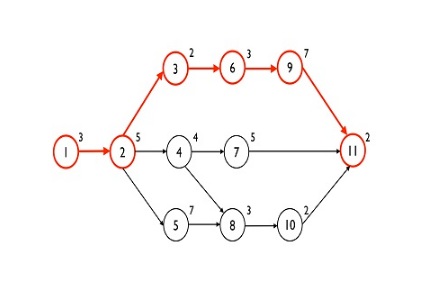In construction, the Critical Path Method (CPM) is a project management technique that identifies critical path activities in stages. The CPM approach to project scheduling includes dividing a project into multiple job tasks, displaying them in a flow chart, and calculating the duration for each task and the overall project duration based on the individual tasks.

In this article, we have covered the Critical Path Method for construction project management.
Table of Contents
What is the Critical Path Method (CPM)?
It is a popular scheduling technique in the construction industry due to its effectiveness and simplicity.
It is used to calculate how much time and resources are required to complete a project and generates a graphical view of a project. CPM also determines critical activities requiring attention so that the project can be completed on time.
No construction project would be completed on time without proper Scheduling to keep the project moving the project schedule should be made up of the tasks that are essential. That brings us to the Critical Path Method which is widely used in the construction industry.
Smaller construction jobs allow for spontaneous planning, bigger projects require construction project management. Generally, project managers use Critical path analysis as a tool, often with their construction management software, to help figure out the best steps to take to finish a job efficiently.
CPM for project management uses a network diagram to graphically illustrate the major activities of a construction project and to show the links between activities. CPM assigns each activity a single fixed duration.
You can also watch the video to understand CPM.
What is the Critical Path Method For Construction?
The CPM is one of the most commonly used techniques for scheduling in construction. It is sometimes referred to as critical path scheduling because it mainly calculates the minimum time needed to complete a construction project alongside the possible start and end times for the different activities.
It is a usable, perfect, and practical scheduling method used by many construction managers. There is also a myriad of computer programs and algorithms for critical path scheduling available that can effectively and efficiently handle projects with multiple activities.
The concept of the critical path method is best illustrated in a project graph (in the old days), or by computer programs that perform the needed calculations without referencing a graph. The project graph visually represents the web of jobs in a construction project and their relationships with each other.
A coding system must be established to identify each construction job required to complete the entire project, which must be accompanied by the length of time needed to accomplish the job, and its immediate prerequisite tasks.
Each job is plotted on the graph as a circle with its coding details and other pertinent data (dates, etc.). Arrows are used to connect the circles (jobs) indicating the sequence relationships. The circles and arrows are depictions of what we refer to as a project network.
Steps for Constructing CPM:
Here are some steps to identify the critical path.
1. Identification of Activities:
First, develop a list of activities of the project which is obtained from the work breakdown structure or from the project scope or detail. Duration and sequence are set up in the next step. Activities are then tagged by name, duration, and coding and must have the duration or target date if a milestone is there.
2. Activity Determination in Sequence:
To prepare and connect the list of activities prepared in the previous step there is a need for a complete knowledge of activities. The activities which are linked to each other or related need to understand by construction managers in order to show the proper connection in the schedule. During the project execution, the contractors fail to understand the link between activities or relationships thus arising problems and causing project delays.
3. Create the Network:
The critical path method (CPM) evolves from summarizing the project activities and their dependencies with each other. With logical coordination and monitoring, all the critical work sequences should be linked. Calendar days as the main planning unit is to be considered as CPM format. Working days in the schedule should be avoided so as to it cannot lead to confusion and errors.
4. Estimation of Activities Completion Time.
From different project experiences or an experienced project manager can estimate project time for how long it will take to complete activities for a single resource unit.
5. Identification of Critical path
The network critical path is said to be the longest duration path. In project planning, critical path analysis is one of the most important aspects. The following parameters can be identified from CPM.
- ES is Early Start:
Earliest time to start a predetermined activity, given that prior activities must be completed first.
- EF is Early Finish:
Earliest finish time for the activity.
- LF is Late Finish:
The latest time the activity must be completed without delaying the entire project.
- LS is Late Start:
Latest start date that the activity must be started without delaying the project.
A path is said to be the critical path in which no activities are delayed i.e the path of Early start is equal to Late start and Early finish is equal to the Late finish for each and every activity in the finish. Thus the delay in the critical path delays the project.
6. Updation of CPM diagram
You can update the critical path when the project is being developed. when all the duration time of the activities is completed analysis of the new critical path can be possible. A new path may be possible and alternative solutions can be given to either accelerate the project or continue working as projected.
